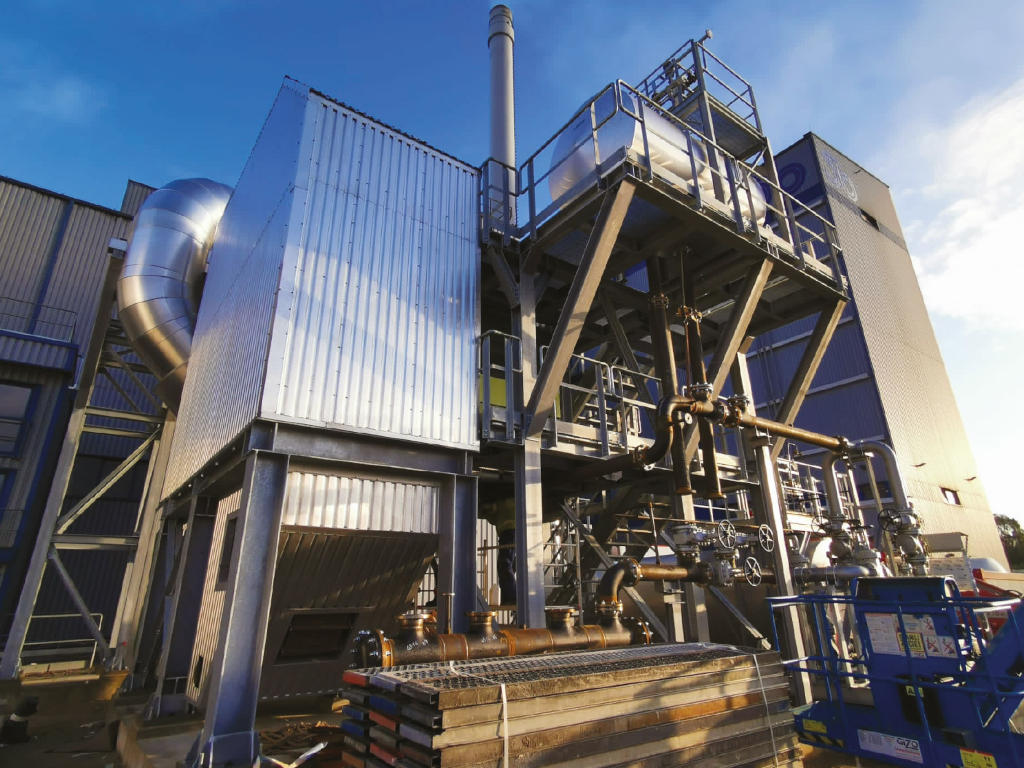A good level of co-operation and communication between the end user and a flue gas cleaning system provider can help to ensure an efficient investment and surprisingly low costs of ownership. Open discussion of strategies and willingness to consider alternative proposals can lead to bespoke solutions that become a real ‘win-win’ project for both parties – for example, a more elegant pollution control solution, performing at the highest efficiency, and generating power from clean, high temperature flue gas that has been there all along.
Two ‘real-life’ stories are presented here, to demonstrate the gains when ‘race-to-the-bottom’ CAPEX management tactics are eschewed in favour of a more collaborative procurement approach between solution providers and buyers.
A new source of power
In this case study, a container glass manufacturer planned to increase the size of one of its furnaces by 45% during the next cold repair, but the new flow rate would be so great that the existing ElectroStatic Precipitator (ESP) filtration system – even though not very old – would no longer able to maintain guaranteed dust emission limits.
The furnace rebuild team had already been in touch with Tri-Mer Global Technologies (TGT) regarding a feasibility study on waste heat recovery, and aware of the company’s credentials as a capable and creative provider of ceramic filter solutions, inquired about a new, modern filtration system based on this technology.
Factoring in wishes for a compact layout and reduced investment costs, an ESP conversion to ceramic filter was proposed instead of a brand-new larger system. This application consists of reusing the external housing of an ESP, removing the internals and the transformers, and modifying [them] to mount and fill the void with ceramic filter elements. Significant advantages could be had from this alternative approach: no civil works; deNOx-ready system; ultra-low dust emission; and – thanks to a modular, pre-fabricated design, completion during and within the same timeframe of the cold repair.
However, the customer seemed to be unhappy about having to invest in a different filter technology only a few years’ on from the previous installation. In close collaboration with the furnace rebuild team, TGT’s engineers tried to find another solution with even more advantages.
The rebuild team assisted immensely with the ensuing information exchange between the new furnace supplier (predicting flue gas temperature range across the entire campaign) and the existing ESP supplier (defining the maximum limits of the ESP’s operation with minor overhaul) and allowing TGT access to all the information it needed to develop a more economic solution without new filters.
Utilising flue gas cooling with a heat exchanger and reducing the actual flue gas flow rate entering the existing ESP would keep it low enough to maintain the guarantee on the requested emissions levels and ensure readiness with an automatic tube cleaning system. Four separate – and sometimes competitive – entities were connected with the common target of developing the best solution for the plant.
Although the primary function of the heat exchanger was for cooling the raw gases, the heat is recovered through a thermal oil loop that, circulating at high temperature, is able to feed an ORC (Organic Ranking Cycle) module for electricity production.
In the end, thanks to the open minded and collaborative approach of the furnace rebuild team and the solution providers involved, a dust emission problem became the source of 700kW of electrical power.
Emission reduction investment
In the second case study, an independent container glass manufacturer with technical confidence in Tri-Mer Global explained the plans for its two-furnace plant. Two cold furnace repairs were to be carried out within 24 months and an ageing ESP needed to be replaced with a more modern technological solution including deNOx capabilities.
Due to the configuration of the plant, creating hot connections to the new filter with the furnaces in operation would not be possible. Additionally, there was a strong interest in power generation from the flue gas heat; a request for a potentially uninterrupted operation of the filtration system during the rebuilds; plus, the solution prepared would need to meet any future regulation restrictions.
The glass producer asked TGT to advise the on best solution, given the timing and all the special needs of the project, with the first overhaul planned only five months later. TGT’s engineers outlined a staged solution suitable for the customer’s requirements, and allowing them to spread the investment across the furnace campaign.
The first step involved the preparation of connections from the first furnace to the future filtration system, during cold repair. Quick engineering and duct manufacturing was requested to profit from the two months’ of operations stoppage.
At the same time, an ultra-efficient, modular catalytic ceramic filter system was developed. The modularity allowed TGT to guarantee the requested availability, with one module potentially off for maintenance while the others continue to operate. The manufacturing and installation of the modules was also phased to allow a faster connection of the first furnace (three modules); while the second furnace remained connected to the old ESP, and all to a common, existing stack. A detailed 3D design was necessary to avoid problems in duct installation. Two additional modules were then installed and ready for the second furnace connection. The modularity of the system was extended to provide maximum flexibility for future needs, with a system ready to easily integrate with the future installation of a sixth module for potential end-of-campaign needs.
Downstream [of] the filtration, working on clean gases, an oil/gas heat exchanger was installed, recovering 9.9MW of heat to feed an ORC module.
With the target of profiting from the high temperatures of the aged furnaces, connections were prepared for the future installation of another heat exchanger (on the raw gas side of the filter), potentially enabling the system to recover 11.2MW, and therefore generate up to 2WM of net power from the ORC.
In both examples, strong and open co-operation between the customer and supplier led to successful and satisfactory solutions.


